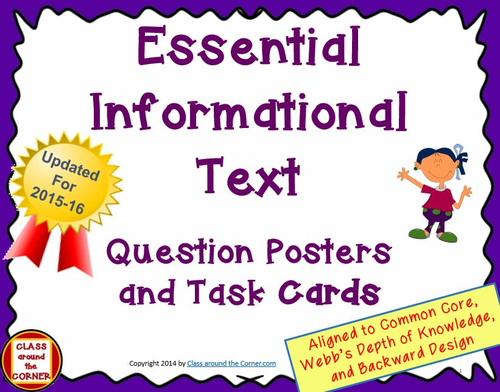





(Aligned to Common Core, Webb’s Depth of Knowledge, and Backward Design.)
A link to hundreds of “free to use” stories from the historic McGuffey Eclectic Readers is included.
This product overs five categories of Informational Text:
Text Features
Explain Relationships
Reasons and Evidence
Text Structure
Integrate Information
Here is a resource to connect kids daily to in-depth thinking and writing about reading. The rigorous questions are kid-friendly. The teacher can use a question to model thinking and get a lively collaborative discussion going in minutes. These 58 questions are not only for teacher modeling and collaborative discussion but also for paired interaction, and for independent journal writing. They correlate with “I Do,” “We Do,” “You Do” and can be adapted as essential questions or “Ticket Out” tasks.
Post them anywhere in your room, or print the task cards for students to use in groups, in centers, or for independent writing. Several posters can be placed together on a board so that you can refer to them throughout the week. The matching task cards will help kids focus on key concepts you are emphasizing in class.
Teacher read-alouds of non-fiction text is important in the reading classroom. Informational text gives the teacher the opportunity to model thinking aloud about text structure and text features. These reading posters will provide a print-rich environment for your students. Kids will make connections between their thinking and the questions. They will get better at responding about reading.
Informational text questions include making personal and textual connections, asking about content, accuracy, relevance, style, text structure and features. Informational text demonstrates predominantly expository structures, which may include arguments, opinions, and information/explanation. Expository text relates to description, sequence or time/order, compare/contrast, cause and effect, and problem/solution. You will see that there are similarities here with the components of literature. These posters will help keep momentum high as students think about reading connections.
Included are reading reward coupons. The rewards are intended for expanded thinking and reasoning and for demonstrating improved depth of knowledge each week. As a result of the teacher modeling thinking and writing, students will become more confident and polished writers. The rewards are for the great ideas you will see kids express on paper.
Check out other resources at my store at https://www.tes.com/teaching-resources/shop/classaroundthecorner.
A link to hundreds of “free to use” stories from the historic McGuffey Eclectic Readers is included.
This product overs five categories of Informational Text:
Text Features
Explain Relationships
Reasons and Evidence
Text Structure
Integrate Information
Here is a resource to connect kids daily to in-depth thinking and writing about reading. The rigorous questions are kid-friendly. The teacher can use a question to model thinking and get a lively collaborative discussion going in minutes. These 58 questions are not only for teacher modeling and collaborative discussion but also for paired interaction, and for independent journal writing. They correlate with “I Do,” “We Do,” “You Do” and can be adapted as essential questions or “Ticket Out” tasks.
Post them anywhere in your room, or print the task cards for students to use in groups, in centers, or for independent writing. Several posters can be placed together on a board so that you can refer to them throughout the week. The matching task cards will help kids focus on key concepts you are emphasizing in class.
Teacher read-alouds of non-fiction text is important in the reading classroom. Informational text gives the teacher the opportunity to model thinking aloud about text structure and text features. These reading posters will provide a print-rich environment for your students. Kids will make connections between their thinking and the questions. They will get better at responding about reading.
Informational text questions include making personal and textual connections, asking about content, accuracy, relevance, style, text structure and features. Informational text demonstrates predominantly expository structures, which may include arguments, opinions, and information/explanation. Expository text relates to description, sequence or time/order, compare/contrast, cause and effect, and problem/solution. You will see that there are similarities here with the components of literature. These posters will help keep momentum high as students think about reading connections.
Included are reading reward coupons. The rewards are intended for expanded thinking and reasoning and for demonstrating improved depth of knowledge each week. As a result of the teacher modeling thinking and writing, students will become more confident and polished writers. The rewards are for the great ideas you will see kids express on paper.
Check out other resources at my store at https://www.tes.com/teaching-resources/shop/classaroundthecorner.
Something went wrong, please try again later.
This resource hasn't been reviewed yet
To ensure quality for our reviews, only customers who have purchased this resource can review it
Report this resourceto let us know if it violates our terms and conditions.
Our customer service team will review your report and will be in touch.
$5.00